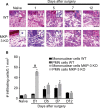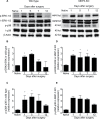Mitogen-activated protein kinase phosphatase-3 (MKP-3) in the surgical wound is necessary for the resolution of postoperative pain in mice
- PMID: 28405172
- PMCID: PMC5378457
- DOI: 10.2147/JPR.S129826
Mitogen-activated protein kinase phosphatase-3 (MKP-3) in the surgical wound is necessary for the resolution of postoperative pain in mice
Abstract
Mitogen-activated protein kinase (MAPK) phosphatase-3 (MKP-3) and its substrates (extracellular signal-regulated kinase [ERK] and p38) play an important role in pathophysiological mechanisms of acute postoperative and chronic neuropathic pain in the spinal cord. This study aimed to understand the role of MKP-3 and its target MAPKs at the site of surgical incision in nociceptive behavior. Wild-type (WT) and MKP-3 knockout (KO) mice underwent unilateral plantar hind paw incision. Mechanical allodynia was assessed by using von Frey filaments. Peripheral ERK-1/2 and p38 phosphorylation were measured by Western blot. Cell infiltration was determined using hematoxylin and eosin histological staining. Peripheral phosphorylated ERK-1/2 (p-ERK-1/2) inhibition was performed in MKP-3 KO mice. In WT mice, mechanical hypersensitivity was observed on postoperative day 1 (0.69±0.17 g baseline vs 0.13±0.08 g day 1), which resolved normally by postoperative day 12 (0.46±0.08 g, N=6). In MKP-3 KO mice, this hypersensitivity persisted at least 12 days after surgery (0.19±0.06 g; N=6). KO mice displayed higher numbers of infiltrating cells (51.4±6 cells/0.1 mm2) than WT mice (8.7±1.2 cells/0.1 mm2) on postoperative day 1 (vs 5-6 cells/0.1 mm2 at baseline) that returned to baseline 12 days after surgery (10-12 cells/0.1 mm2). In WT mice, peripheral p-p38 and p-ERK-1/2 expression increased (5- and 3-fold, respectively) on postoperative days 1 and 5, and returned to basal levels 7-12 days after surgery (N=3 per group). Peripheral p-p38 levels in MKP-3 KO mice followed a similar expression pattern as WT mice. Peripheral p-ERK-1/2 levels in MKP-3 KO mice remained elevated 12 days after surgery (2.5-fold, N=3 per group). Administration of PD98059 (MEK inhibitor, N=8, vehicle N=9) reduced p-ERK-1/2 expression in the incised tissue and blocked hypersensitivity in MKP-3 KO mice (N=6). The findings of this study suggest that MKP-3 is pivotal for normal resolution of acute postoperative allodynia, through the regulation of peripheral p-ERK-1/2.
Keywords: DUSP-6; ERK; p38.
Conflict of interest statement
Disclosure The authors report no conflicts of interest in this work.
Figures





Similar articles
-
Spinal mitogen-activated protein kinase phosphatase-3 (MKP-3) is necessary for the normal resolution of mechanical allodynia in a mouse model of acute postoperative pain.J Neurosci. 2013 Oct 23;33(43):17182-7. doi: 10.1523/JNEUROSCI.5605-12.2013. J Neurosci. 2013. PMID: 24155322 Free PMC article.
-
Spinal cannabinoid receptor type 2 agonist reduces mechanical allodynia and induces mitogen-activated protein kinase phosphatases in a rat model of neuropathic pain.J Pain. 2012 Sep;13(9):836-48. doi: 10.1016/j.jpain.2012.05.013. Epub 2012 Aug 14. J Pain. 2012. PMID: 22901764 Free PMC article.
-
Whole Genome Microarray Analysis of DUSP4-Deletion Reveals A Novel Role for MAP Kinase Phosphatase-2 (MKP-2) in Macrophage Gene Expression and Function.Int J Mol Sci. 2019 Jul 12;20(14):3434. doi: 10.3390/ijms20143434. Int J Mol Sci. 2019. PMID: 31336892 Free PMC article.
-
Mitogen activated protein kinase phosphatase-1 prevents the development of tactile sensitivity in a rodent model of neuropathic pain.Mol Pain. 2012 Apr 27;8:34. doi: 10.1186/1744-8069-8-34. Mol Pain. 2012. PMID: 22540262 Free PMC article.
-
Compartment-specific regulation of extracellular signal-regulated kinase (ERK) and c-Jun N-terminal kinase (JNK) mitogen-activated protein kinases (MAPKs) by ERK-dependent and non-ERK-dependent inductions of MAPK phosphatase (MKP)-3 and MKP-1 in differentiating P19 cells.Biochem J. 2000 Dec 15;352 Pt 3(Pt 3):701-8. Biochem J. 2000. PMID: 11104676 Free PMC article.
Cited by
-
Dual-Specificity Phosphatase Regulation in Neurons and Glial Cells.Int J Mol Sci. 2019 Apr 23;20(8):1999. doi: 10.3390/ijms20081999. Int J Mol Sci. 2019. PMID: 31018603 Free PMC article. Review.
-
Andrographolide Relieves Post-Operative Wound Pain but Affects Local Angiogenesis.Pharmaceuticals (Basel). 2022 Dec 19;15(12):1586. doi: 10.3390/ph15121586. Pharmaceuticals (Basel). 2022. PMID: 36559037 Free PMC article.
-
Dual-Specificity Phosphatase 6 Deficiency Attenuates Arterial-Injury-Induced Intimal Hyperplasia in Mice.Int J Mol Sci. 2023 Dec 5;24(24):17136. doi: 10.3390/ijms242417136. Int J Mol Sci. 2023. PMID: 38138967 Free PMC article.
-
Recent development in antihyperalgesic effect of phytochemicals: anti-inflammatory and neuro-modulatory actions.Inflamm Res. 2018 Aug;67(8):633-654. doi: 10.1007/s00011-018-1156-5. Epub 2018 May 16. Inflamm Res. 2018. PMID: 29767332 Review.
-
MIF mediates bladder pain, not inflammation, in cyclophosphamide cystitis.Cytokine X. 2019 Mar;1(1):100003. doi: 10.1016/j.cytox.2019.100003. Epub 2019 Jan 23. Cytokine X. 2019. PMID: 31289792 Free PMC article.
References
-
- Macrae WA. Chronic post-surgical pain: 10 years on. Br J Anaesth. 2008;101(1):77–86. - PubMed
-
- Wu CL, Raja SN. Treatment of acute postoperative pain. Lancet. 25. 2011;377(9784):2215–2225. - PubMed
-
- Wen YR, Suter MR, Ji RR, et al. Activation of p38 mitogen-activated protein kinase in spinal microglia contributes to incision-induced mechanical allodynia. Anesthesiology. 2009;110(1):155–165. - PubMed
-
- Tong SE, Daniels SE, Black P, Chang S, Protter A, Desjardins PJ. Novel p38alpha mitogen-activated protein kinase inhibitor shows analgesic efficacy in acute postsurgical dental pain. J Clin Pharmacol. 2012;52(5):717–728. - PubMed
LinkOut - more resources
Full Text Sources
Other Literature Sources
Molecular Biology Databases
Research Materials
Miscellaneous

